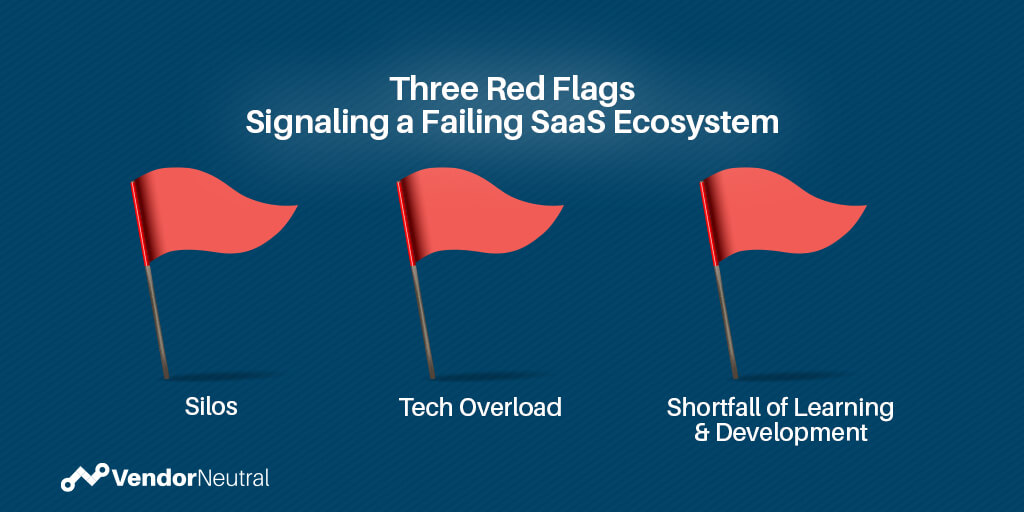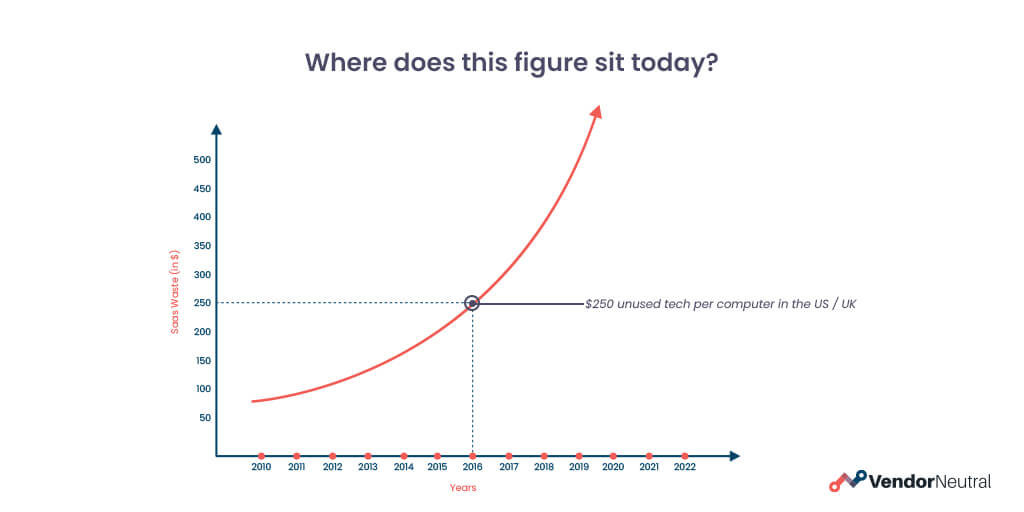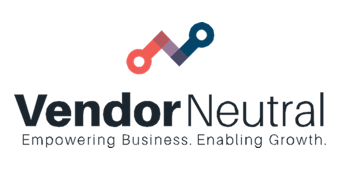3 Red Flags Signaling a Failing Sales SaaS Ecosystem
SaaS applications make up 70% of total company software use: if Sales SaaS fails to deliver, then so too does your business.

But how do you spot a troubled relationship with SaaS in your company? What are the signs that SaaS isn’t curing the ills you purchased it to?
Whether it’s in front-line stress or diminishing bottom line returns, you’re aware that even though everyone is working at capacity, something isn’t working – but before you blame your tech stack, or lack thereof, take a step back.
Our forensic relationship with over 80 organizations around the globe means we know the red flags that signal trouble with SaaS and the ecosystem around it – and you should too.
Read on for the characteristics that indicate your organization might have problems that no Sales SaaS can solve…
Sort out Silos
Most work time (anywhere from 50 to 80 percent) is spent on communication, so it’s no shock that our work day is played out against a soundtrack of Sales SaaS hoping to facilitate it: the pings of Slack, the incoming Zoom call or email notification pop ups.
So your team is BUSY talking, but are they communicating?
This matters, because poor comms produce silos.
- 54% of organizations report their customer experience operations are managed in silos
- And amazingly, only 33% of customer experience professionals say they can actively communicate and collaborate across teams
What does this mean for customer churn and repeat sales? Nothing good.
Silos can allow the business to be divided into individual profit and loss centers with the aim of making bigger businesses more manageable. You can break-up organizations into bite size chunks, assign leaders within these units to focus on their niches.
But, this approach often falls down in cross-collaboration, group strategic alignment and, when it comes to Sales SaaS, a world of chaos. Individual silos shooting from the hip to procure software on a whim, and with it, all of the drawbacks that come from ‘short-termism’ thinking.
Often, goals of each business unit do not align with the greater purpose and strategic destination of the company. Not only do you need everyone to be on board with the vision, you need them to be heading in that direction as a collective.
Reflect: Is your company vision and strategy visible to all stakeholders? Have they bought into it?
If not, the antidote is not SaaS!
Instead administer communication, visibility and adherence to processes, plus a dose of strong leadership…or get support by putting our auditing and consultancy services in play. Read more about fixing process and strategy on our ‘step by step guide to driving digital transformation‘.
'Too Much Tech' Filling Up Your Sales SaaS Tech stack
A study in 2016 reported that on average $250 of tech sat unused on every computer in the US and UK. Can you imagine how that figure will have leaped in the interim years’ SaaS explosion?

That overlapping tech / redundant tech / underused tech is a waste of money and often a waste of your sales team’s time too.
After an audit of one enterprise level client’s tech stack we found we could reduce their overall annual spend (on over 200 pieces of tech / software / apps across the organization) by an incredible 80%.
If tech interrupts or lengthens or confuses a workflow, it’s time to tackle it.
Red flags that tech could be tripping up your teams:
- Different business units / locations use different apps – with no central oversight of their efficacy or evaluation of their impact
- No centralized role exists for responsibility or for accountability for Sales SaaS selection, procurement or renewal
- Your subscriptions increase year on year (or even month by month), but you see little ROI
- You do not know how many SaaS solutions are in your organization
Even if you tidy up your tech, in our experience organizations who think they have a tech issue, actually have a systemic issue around strategy or process…read on for our final red flag.
We know selecting the right tech for your organization is a challenge, but here is a good starting point – the Vendor Neutral Sales Tech Stack Selection Tool.
Onboard or Off track
Informal or reactive onboarding to a new piece of Sales SaaS tech sound familiar?
Unsurprising given that the training window vendors offer for the new piece of tech you’ve bought tends to be limited to a 30, 60, or max. 90 days.
Onboarding must be strategic: a plan from the ground-level building of the ecosystem around the tech, taking teams forward with the tech towards clear goals. And this is not often possible within the limits of the vendor’s timeframe.
But if you haven’t found a solution for expanding the window to support true onboarding, you must. Low rates of adoption stall your SaaS strategy at the start-line.
Take a look at the roles you have around Learning and Development: do you have a ‘transformational sage’ – a guide, leading a strategy, for colleagues to turn to to support their adoption of tech?
Without an overhaul of HOW you plan for tech and embed it into your organization, tech loses its teeth.
It’s not a quick fix, but if you want tech to truly transform your business, you need to secure it to process, process, process.

The old adage has never been more true: NT + OP = EOP
New tech + old process = expensive old process …
Taking on the task of strategic and systemic digital transformation can sometimes be the only way you can truly address a wilting Sales SaaS ecosystem.
And that’s where Vendor Neutral steps in: if any of the above flags feel familiar, we can support you. Book in a 15 minute discovery call to see how we can audit your Sales SaaS ecosystem and, if needed, work with you to get it functioning more efficiently long-term.
Book your 15 minute discovery call – HERE


